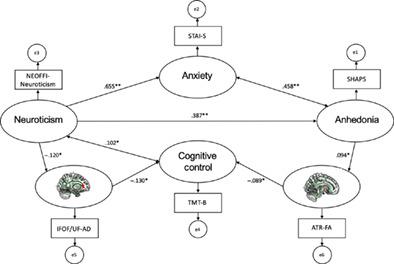当前位置:
X-MOL 学术
›
Hum. Brain Mapp.
›
论文详情
Our official English website, www.x-mol.net, welcomes your
feedback! (Note: you will need to create a separate account there.)
Brain structural connectivity, anhedonia, and phenotypes of major depressive disorder: A structural equation model approach
Human Brain Mapping ( IF 3.5 ) Pub Date : 2021-07-24 , DOI: 10.1002/hbm.25600 Julia-Katharina Pfarr 1, 2 , Katharina Brosch 1, 2 , Tina Meller 1, 2 , Kai Gustav Ringwald 1, 2 , Simon Schmitt 1, 2 , Frederike Stein 1, 2 , Susanne Meinert 3 , Dominik Grotegerd 3 , Katharina Thiel 3 , Hannah Lemke 3 , Alexandra Winter 3 , Lena Waltemate 3 , Tim Hahn 3 , Nils Opel 3 , Jonathan Repple 3 , Jochen Bauer 4 , Andreas Jansen 1, 2 , Udo Dannlowski 3 , Axel Krug 1, 2, 5 , Tilo Kircher 1, 2 , Igor Nenadić 1, 2
Human Brain Mapping ( IF 3.5 ) Pub Date : 2021-07-24 , DOI: 10.1002/hbm.25600 Julia-Katharina Pfarr 1, 2 , Katharina Brosch 1, 2 , Tina Meller 1, 2 , Kai Gustav Ringwald 1, 2 , Simon Schmitt 1, 2 , Frederike Stein 1, 2 , Susanne Meinert 3 , Dominik Grotegerd 3 , Katharina Thiel 3 , Hannah Lemke 3 , Alexandra Winter 3 , Lena Waltemate 3 , Tim Hahn 3 , Nils Opel 3 , Jonathan Repple 3 , Jochen Bauer 4 , Andreas Jansen 1, 2 , Udo Dannlowski 3 , Axel Krug 1, 2, 5 , Tilo Kircher 1, 2 , Igor Nenadić 1, 2
Affiliation

|
Aberrant brain structural connectivity in major depressive disorder (MDD) has been repeatedly reported, yet many previous studies lack integration of different features of MDD with structural connectivity in multivariate modeling approaches. In n = 595 MDD patients, we used structural equation modeling (SEM) to test the intercorrelations between anhedonia, anxiety, neuroticism, and cognitive control in one comprehensive model. We then separately analyzed diffusion tensor imaging (DTI) connectivity measures in association with those clinical variables, and finally integrated brain connectivity associations, clinical/cognitive variables into a multivariate SEM. We first confirmed our clinical/cognitive SEM. DTI analyses (FWE-corrected) showed a positive correlation of anhedonia with fractional anisotropy (FA) in the right anterior thalamic radiation (ATR) and forceps minor/corpus callosum, while neuroticism was negatively correlated with axial diffusivity (AD) in the left uncinate fasciculus (UF) and inferior fronto-occipital fasciculus (IFOF). An extended SEM confirmed the associations of ATR FA with anhedonia and UF/IFOF AD with neuroticism impacting on cognitive control. Our findings provide evidence for a differential impact of state and trait variables of MDD on brain connectivity and cognition. The multivariate approach shows feasibility of explaining heterogeneity within MDD and tracks this to specific brain circuits, thus adding to better understanding of heterogeneity on the biological level.
中文翻译:

重度抑郁症的脑结构连接、快感缺失和表型:结构方程模型方法
重度抑郁症 (MDD) 的异常大脑结构连接已被反复报道,但许多先前的研究缺乏将 MDD 的不同特征与多变量建模方法中的结构连接相结合。在n = 595 名 MDD 患者,我们使用结构方程模型 (SEM) 在一个综合模型中测试快感缺失、焦虑、神经质和认知控制之间的相互关系。然后,我们分别分析了与这些临床变量相关的扩散张量成像 (DTI) 连通性测量,最后将大脑连通性关联、临床/认知变量整合到多变量 SEM 中。我们首先确认了我们的临床/认知 SEM。DTI 分析(FWE 校正)显示,在右侧丘脑前辐射 (ATR) 和小镊子/胼胝体中,快感缺失与分数各向异性 (FA) 呈正相关,而神经质与左钩骨中的轴向扩散率 (AD) 呈负相关束(UF)和额枕下束(IFOF)。扩展的 SEM 证实了 ATR FA 与快感缺失和 UF/IFOF AD 与影响认知控制的神经质相关。我们的研究结果为 MDD 的状态和特征变量对大脑连接和认知的不同影响提供了证据。多变量方法显示了解释 MDD 内异质性的可行性,并将其跟踪到特定的大脑回路,从而更好地理解生物学水平的异质性。
更新日期:2021-09-19
中文翻译:

重度抑郁症的脑结构连接、快感缺失和表型:结构方程模型方法
重度抑郁症 (MDD) 的异常大脑结构连接已被反复报道,但许多先前的研究缺乏将 MDD 的不同特征与多变量建模方法中的结构连接相结合。在n = 595 名 MDD 患者,我们使用结构方程模型 (SEM) 在一个综合模型中测试快感缺失、焦虑、神经质和认知控制之间的相互关系。然后,我们分别分析了与这些临床变量相关的扩散张量成像 (DTI) 连通性测量,最后将大脑连通性关联、临床/认知变量整合到多变量 SEM 中。我们首先确认了我们的临床/认知 SEM。DTI 分析(FWE 校正)显示,在右侧丘脑前辐射 (ATR) 和小镊子/胼胝体中,快感缺失与分数各向异性 (FA) 呈正相关,而神经质与左钩骨中的轴向扩散率 (AD) 呈负相关束(UF)和额枕下束(IFOF)。扩展的 SEM 证实了 ATR FA 与快感缺失和 UF/IFOF AD 与影响认知控制的神经质相关。我们的研究结果为 MDD 的状态和特征变量对大脑连接和认知的不同影响提供了证据。多变量方法显示了解释 MDD 内异质性的可行性,并将其跟踪到特定的大脑回路,从而更好地理解生物学水平的异质性。











































 京公网安备 11010802027423号
京公网安备 11010802027423号